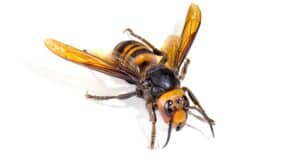If you’re wondering how to get rid of a hornet’s nest, chances are it’s not just idle curiosity that’s motivating you. Maybe you’ve been noticing an unusual number of stinger-equipped insects flitting around the backyard and giving you the side-eye. Perhaps you spotted one of their telltale papery nests tucked in a corner of your front porch. On the one hand, you want to evict the scary little creatures. On the other hand…well, they might sting you on the other hand, so you’re not eager to get too close. Don’t worry. With some careful planning and cautious action, you can give hornets the heave-ho.
Hornet or Wasp?
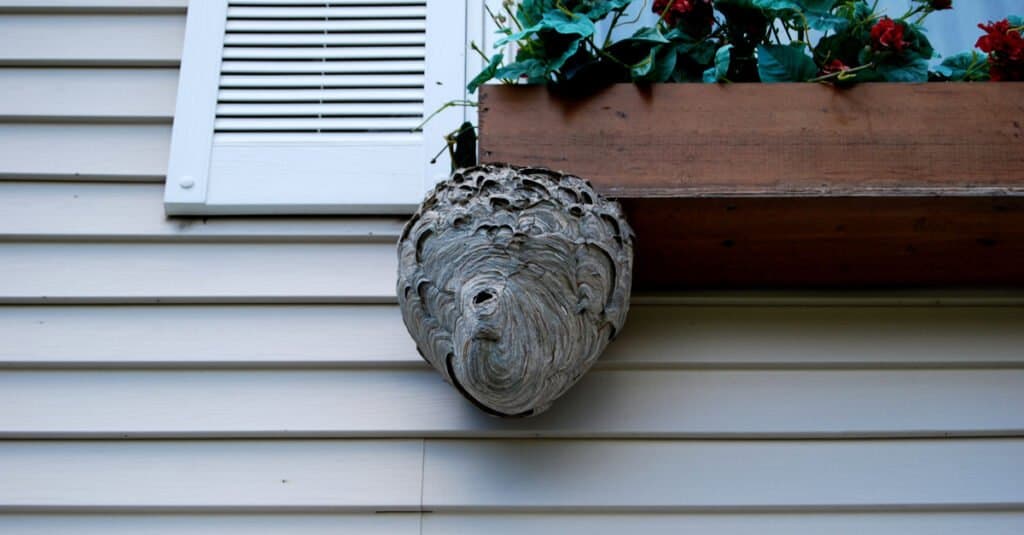
Empty nest? Hornet and wasp nests are abandoned at summer’s end.
©Klod/Shutterstock.com
For the record, the hornet’s nest you’re worried about is actually a wasp’s nest. What’s the difference between a hornet and a wasp? Actually, the two terms overlap. Wasp is the more general term, referring to a group of insects in the same taxonomic order as ants and bees. A hornet is a type of wasp, belonging to a group of 20 or so species (out of the tens of thousands of wasp species). Hornets tend to be bigger than other types of wasps, and not as brightly colored. Most wasps are solitary, but some, including all hornets, live in social groups and build nests.
While it’s true that hornets and other wasps can sting, and that unlike bees they can sting multiple times, that doesn’t mean that spotting a nest on your property is an automatic cause for concern. Wasps are beneficial insects that pollinate plants and disperse seeds. They also prey on pest insects like aphids and caterpillars that munch on vegetable gardens and commercial crops alike. So your first step in dealing with a wasp nest should be to decide if it’s actually a problem. Could a nest that’s located in a remote area of your property be avoided until the end of the summer? Wasp colonies typically die off in the fall, with only the queen surviving to build a new nest, somewhere else, in the following spring.
What Kind of Wasp are you Dealing With?
Only a few species of wasps and hornets are problematic, but that’s not much comfort if you end up on the business end of their stingers. Here’s a look at the usual suspects:

Paper wasp nests are uncovered, meaning you can see the comb-like structure.
©Sarah2/Shutterstock.com
Paper wasps are brownish wasps with yellowish markings. They have long legs that dangle beneath them when they fly. Their papery nests are recognizable by the exposed honeycomb structure, which has no protective covering over it. Paper wasps will build their nests on almost any aboveground horizontal surface. Along with tree limbs, this includes human structures like the eaves of houses, and beams and supports in garages, sheds, attics, and barns. Paper wasps tend not to be aggressive unless defending their nest.
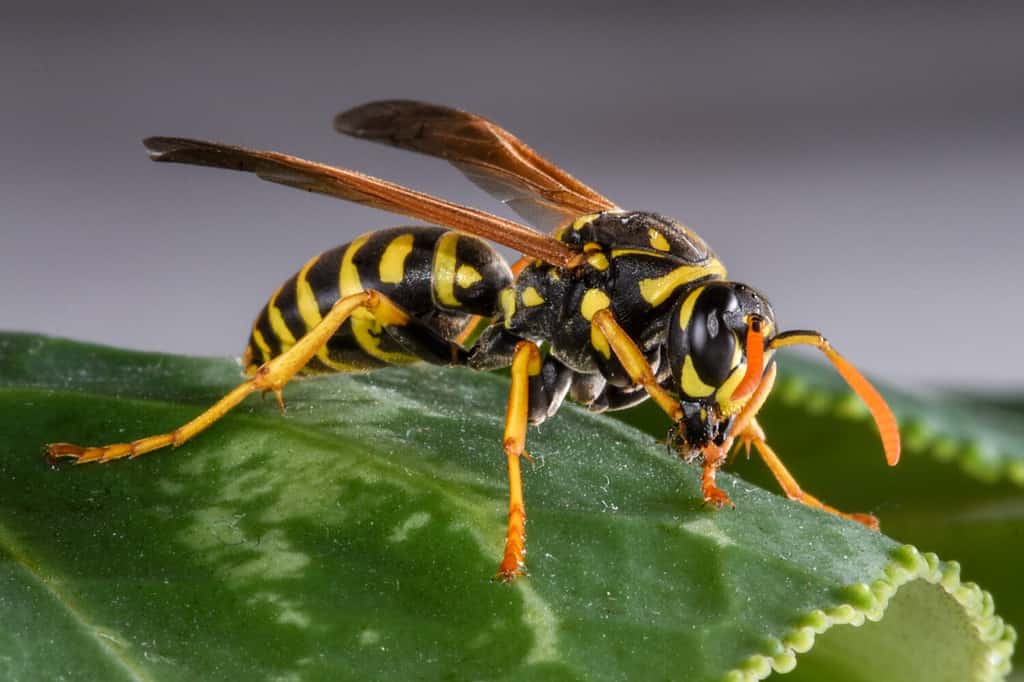
Danger sign: black and yellow markings give the yellowjacket its distinct appearance.
©Randy Runtsch/Shutterstock.com
Yellowjackets, famous for their black and yellow markings, might be mistaken for honey bees. But unlike bees, yellowjackets have few hairs on their bodies. Yellowjackets are more aggressive than most wasps, especially near their nest. They also have a taste for sugar, so they can become a nuisance at picnics or where trash is kept.
Depending on the species, yellowjackets can build nests below ground, in a burrow or cavity, or in a hollow log. They might use spaces within landscape timbers or in wall voids. Other species make gray, papery, rounded nests, covered by an external layer, that hang in trees or under building eaves.
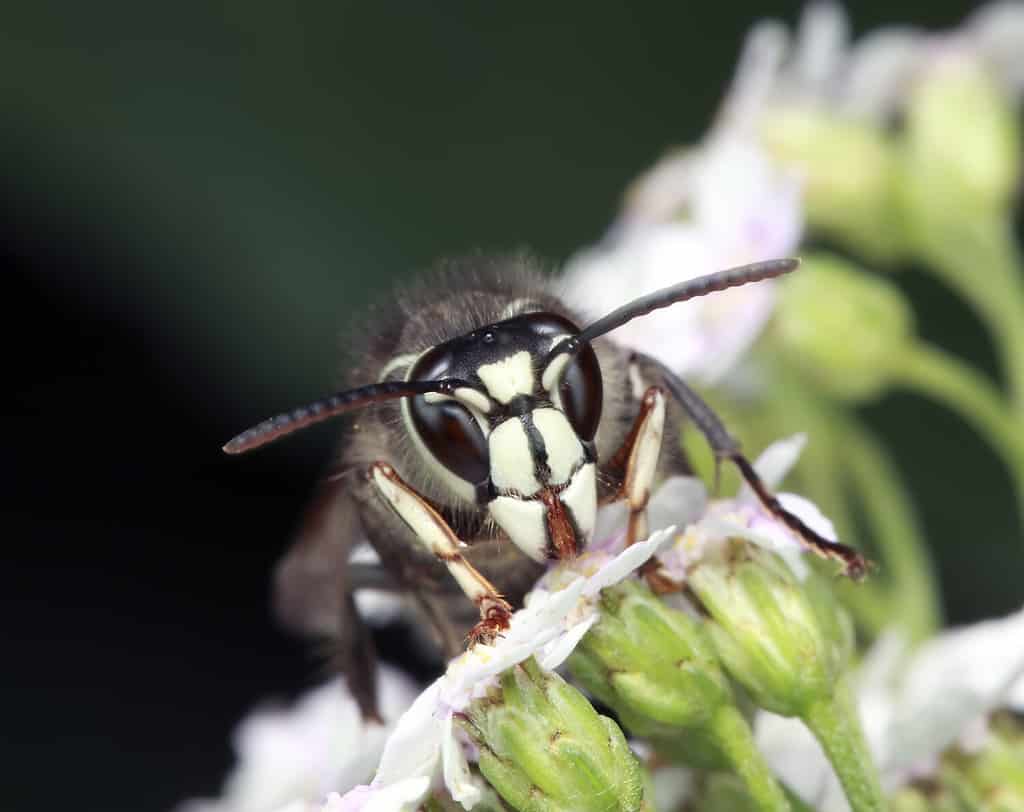
Bald-faced hornets aren’t actually hornets.
©5D2/Shutterstock.com
Bald-faced hornets have white or ivory markings on their face and body. Despite their name, they’re not actually hornets, but a type of yellowjacket (though they’re more white than yellow…come on, BFH, pick a lane). They make above-ground nests, usually three feet off the ground or more.

European hornets are also found in North America.
©Ger Bosma Photos/Shutterstock.com
European hornets, though native to Europe and Asia, have become well established in the Eastern U.S. They’re the only true hornet species in North America. They’re probably the largest wasp commonly encountered, reaching up to an inch long or more. European hornets have red and yellow heads, and their abdomens are black or brown where attached to the body, and yellow at the stinger end. Rather than hanging nests, they tend to build their nests crammed into a protected space, like a tree hollow. Most are found in forested areas, but they also turn up in parks and suburban landscapes. They’re not among the most aggressive hornets, but will sting if provoked or if defending their nest.
How to Get Rid of a Wasp or Hornet Nest
So you’ve noticed a nest that’s too close for comfort. Don’t panic. You have lots of options.
Wait it out. As mentioned, a wasp colony will die off in the fall, after which you can knock the nest down (or put soil over the entrance to a ground nest). The surviving queen will hibernate through the winter and find a new spot to start a colony in the spring. This strategy is especially useful towards the end of summer when wasps are at their most numerous and most aggressive.
Call a professional. If you think you might be allergic to wasp stings, or you just don’t want to get up close and personal with a wasp nest, contact a pest management company. Ditto if the nest is hard to reach; it’s not good to be on a ladder when a swarm of wasps comes at you. Talk to pest removers about their methods and make sure you’re ok with whatever chemical treatment they may use.
Zap an above-ground nest with pesticide. Most hardware and home supply stores sell wasp-specific treatments. Follow the instructions exactly. Do the deed at night, when wasps are less active, and wear protective clothing that covers as much skin as possible. Spray the nest, then return in the morning to knock it down.
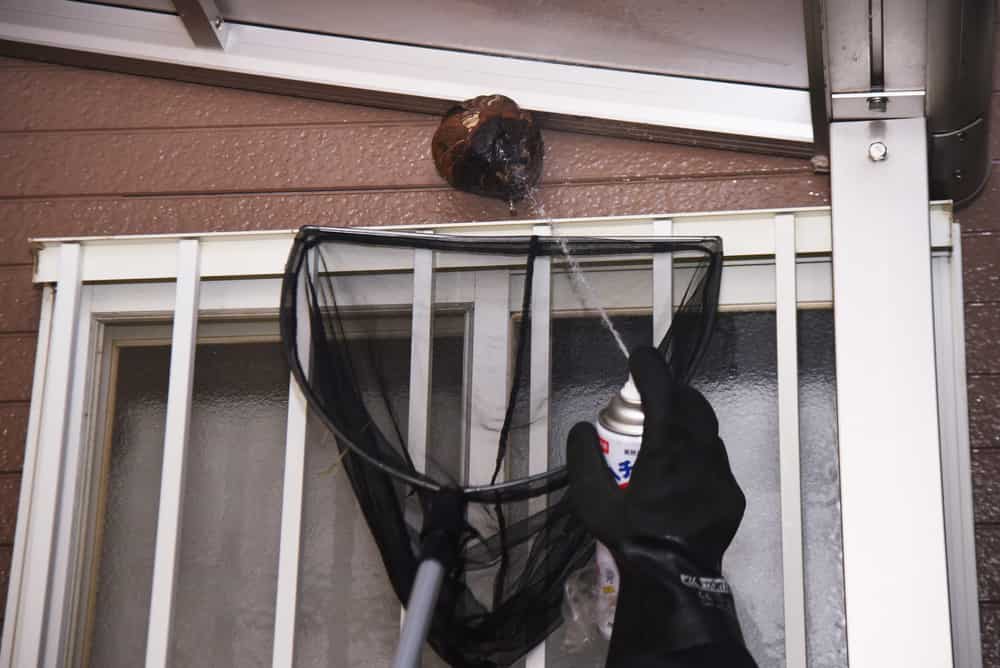
You can utilize long-range wasp spray to target nests high off the ground.
©tamu1500/Shutterstock.com
Try diatomaceous earth for a ground nest. A powder made from fossilized algae, diatomaceous earth kills insects by damaging their exoskeletons. Spread a generous layer around and into the nest entrance, and repeat until the wasps die off. Apply the power at night, and wear protective clothing. You can also try regularly spraying around the nest with white vinegar, which may eventually get them to abandon the site. Take proper protective precautions, though, because those will be some mad wasps.
Flood them out. For a more dramatic solution, mix a gallon of water with some dish soap. Cover the nest hole with landscaping fabric, pinning or weighting it in place. Cut a slit in the fabric over the hole, then pour the soapy water into it. Or squirt some dish soap in, then flood the nest using a garden hose. The soap will make it hard for the wasps to fly, and the water will drown them. We’ll say it again: do all this at night, while wearing protective clothing.
What Not to Do
We get it, you don’t want any flying stabby insects hanging around your house. But that’s no excuse for any of these rash actions.
Don’t use gasoline. Pouring gasoline into a ground nest creates a fire hazard, kills off vegetation, and contaminates the soil. Likewise, trying to wipe out an aboveground nest with gas fumes exposes your own lungs to toxic vapors, creates a fire hazard, may lead to spilled gasoline, and at best will only work on a small nest. Plus you have to dispose of the gasoline safely.

Pouring gasoline in a ground nest carries a triple whammy–fire hazard, dead vegetation, and contaminated soil.
©Quality Stock Arts/Shutterstock.com
Stay off ladders. As mentioned, you don’t want to be on a ladder when wasps attack. The next thing you know you’re on the ground with a twisted ankle or broken leg, which won’t make escaping the wasps any easier. Maybe you can crawl away while they’re laughing at you.
Don’t just cover up the hole and walk away smiling. The wasps already dug one hole, what makes you think they can’t dig out a new one? Plugging up the entrance to a ground nest will cause the insects to create a new entrance, which might be in a worse spot than the first one. This is especially true for a nest that’s inside a wall: you don’t want those wasps creating an opening that lets them into your living space.
The photo featured at the top of this post is © Manu M Nair/Shutterstock.com
Thank you for reading! Have some feedback for us? Contact the AZ Animals editorial team.






